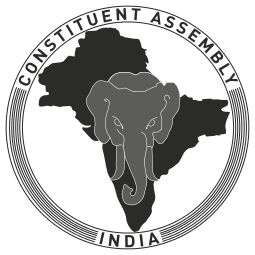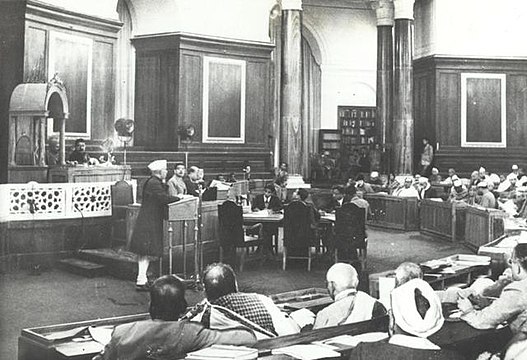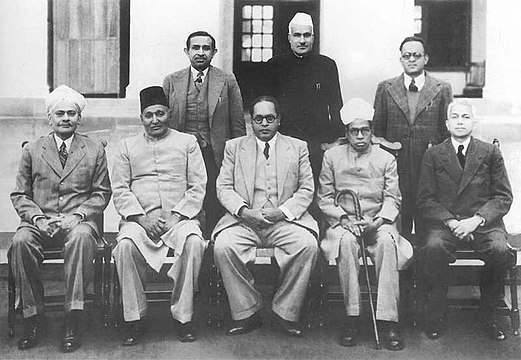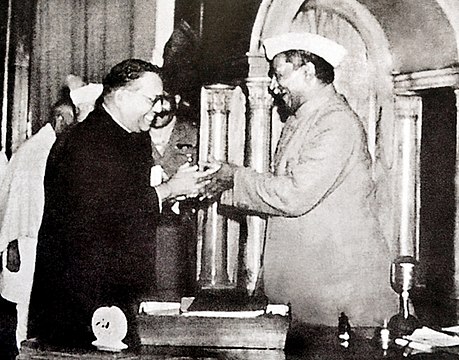वापस जायें / Back
Constituent Assembly of India

Constituent Assembly of India was constituted to prepare the Constitution of India. After independence, the members of the Constituent Assembly became Members of the first Parliament of India.
Discussion about making a Constitution for India had been going on since long. In 1925, Mahatma Gandhi presented the Commonwealth of India Bill, which was the first attempt to present the outline of a constitutional system for India. The demand for a Constituent Assembly was raised for the first time by Bal Gangadhar Tilak in 1895.
After the end of the Second World War in July 1945, the new Government in Britain decided to make a committee for preparing a consititution of India as preparation for independence of India. Members of Constituent Assembly were elected by a system indirect elections, by the elected representatives in State Assemblies, in July 1946. After the partition of India, out of the 389 members of the Constituent Assembly, 299 remmained in India and the rest went to Pakistan and constituted the Constituent Assembly of Pakistan. Out of the 299 members in the Constituent Assembly of India, 229 were elected and 70 were nominated. The number of women members was 15. 26 members were from Scheduled Castes and 33 from Scheduled Tribes. After partition, 3 women went to Pakistan and 12 remained in India.

After India became Independent on 15th August 1947, the Constituent Assembly became sovereign. The Asssembly started working on 1 December 1946. Dr Rajendra Prasad, Dr Bhimrao Ambedkar, Sardar Vallabh Bhai Patel, Shyama Prasad Mukherjee, Jawaharlal Nehru, Maulana Abul Kalam Azad, etc., were its prominent members. Sachidanand Sinha was its first Chairman. Later, Dr Rajendra Prasad was elected Chairman. Bhimrao Ambedkar was elected Chairman of the drafting committee. Constituent Assembly had 165 sittings in 2 years, 11 months and 18 days. Press and Public were allowed in its sittings.
Important events of the Constituent Assembly are -
- 6th December 1946 - Assembly was constituted.
- 9th December 1946 - First meeting of the Constituent Assembly was held in the Central Hall of the old Parliament House. Muslim League boycotted the meeting demanding a separate country.
- 11th December 1946- Dr Rajendra Prasad was elected Chairman of the Constituent Assembly.
- 13th December 1946 Jawaharlal Nehru presented the resolutions of Aims and Objects of the Constitution to the Assembly. Jawahaharlal Nehru said at that time -
'We have been cutting our way and clearing the ground on which we Intend to erect the edifice of a constitution. It, however, seems proper that before we proceed further we should clearly understand where we are going and what we intend building.......The Resolution that I am placing before you is in the nature of a pledge.'

- It was passed unanimously on 22nd December, 1946 after 8 days debate. Thereafter, the Assembly constituted several commisttees to prepare the draft of the Constitution.
- On 17th March 1947, the Consultation Committee sent a questionnaire to the Central and Provincial Assemblies about the main features of the proposed Consititution. The Committee prepared a report on the basis of the replies received. The draft of the Constitution was prepared based on it.
- The Constituent Assembly approved the Tricolour Flag as the National Flag of India on 22nd July 1947.
- India became Independent on 15th August 1947.
- Drafting Committee was constituted on 29th August 1947, the chairman of which was Dr Babasahab Ambedkar. Other members of the Committee were- Kanhaiyalal Munshi, Mohammed Sadullah, Alladi Krishnaswami Ayyar, Goplaswami Ayangar, N. Madhav Rao, who was inducted in place of B.L. Mittar, who resigned due to ill health, and T.T. Krishnamachari, who was inducted in place of Deviprasad Khetan.

- Constitution of India was enacted on 26th November 1949, by the Constituent Assembly and certian articles came into force the very same day.

- All members signed the Constitution in a special meeting of the Constituent Assembly on 24th January 1950.
- The Constitution came into force on 26th January 1950.
Both Hindi and English copies of the original Constitution are signed copies. They were transcribed by Prem Bihari Raizada with a nib and holder pen in italic style Calligraphy. The Constitution was printed in Dehradoon and was photographed by Survey of India. Artists of Shantiniketan under the guiadance of Acharya Nandlal Bose, have made ornate paintings to decorate the original copies of the Consitition. The page of Preamble was prepared by B. Ram Manohar Sinha. Both Hindi and English original copies of the Constitution are kept in the Library of Parliament. They are kept in a container filled with Helium gas. There were long debates before the final draft of the Constitution was accepted with 2000 amendments.

Salient featutres of the Constituion of India are -
- It is the longest written Constitution of the World.
- Many provisions of the Constitution of India have been taken from Constitutions of other countries and from the Government of India Act, 1935. Dr B. R. Ambedkar had said with pride, that the Constitution has been prepared from the essence of all known Constitutions of the World. Fundamental rights and Directive Principles of State Policy are inspired respectively from the American and Irish Constitutions. The idea of a Cabinet form of Government and relationship between Executive and Legislature is British in origin.
- Blend of Rigidity and Flexibility - Three types of amendments are provided in the Indian Constitution with various levels of flexibility.
- Federal system with a Unitary Bias -
The Federal system in India, includes -
Separate Union and State Governments, division of powers, written Constitution, Primacy of the Constitution, Rigidity of the Constitution, Independent Judiciary and two houses of Parliament.
However, there is also a Unitary bias in the Constitution, such as, strong center, appointment of Governors by the Union Government, All India Services, Unified Judiciary etc.
'Federation' word has nowhere been used in the Constitution. According to Article-1 of the Constitution, India is a Union of States, but this Union is not the result of any agreement among the States and no State has the right of secession).
- Parliamentary form of Government - In India, Parliamentary Government is based on majority in the Parliament.
The principle of sovereignty of the Parliament has been taken from the British Parliament and the principle of Judicial supremacy is taken from the American Supreme Court. However, the power of Judicial review in India is narrower as compared to the United States, because instead of the words 'Procedure established by Law' in the American Constitution, words 'Reasonable procedure of Law' have been used in the Indian Constitution. Parliament can use its sovereign power to amend most of the Constitution, but the Supreme Court can declare laws made by the Parliament to be ultra vires of the Constitution under its powers of judicial review.
- Rule of Law - No person is above the law. Law is supreme in democracy. There is no scope for arbitrariness.
- Unified and Independent Judiciary.
- Fundamental Rights - Part III of Consititution of India guarantees 6 fundamental rights to everyone. They cannot be repealed by any majority. These rights act as a limit to the tyranny of the Executive and arbitrariness of the Legislature.
- Directive Principles of State Policy - Directive Principles have been included under Part IV of our Constitution to provide Social and Economic Justice to the people.
- Fundamantal Duties- These were added in the Constitution in 1976 by the 42nd Amendment.
- Indian Secularism - The Constitution provides that the State shall not associate itself with any religion and shall not be controlled by any religion. Every citizen shall have the right to follow any religion, in which the right of being an atheist is also included. There can be no discrimination on the basis of religion.
- Universal Adult Franchise.
- Single Citizenship
- Independent Institutions - Indian Constitution has established some Indpendent Institutions, which are necessary for democratic system to function, e.g Independent Election Commission.
- Emergency Provisions - Emergeny provisions have been kept in the Constitution for such situations, when Government cannot be run as per normal Constitutional Provisions. Emergency is of three types –
- War, External Aggression or Armed rebellion (Article 352)
- Failure of Constitutional machinery in the States (Articles 356 and 365)
- Financial Emergency (Article 360)
- Third tier of Government- Third tier of Government for Panchayats and Urban Local Bodies has been added by the 73rdth Constitutional Amendments.
Sources of the Constitution of India -
- Government of India Act 1935 – Federal scheme, Office of Governor, Judiciary, Public Service Commission, Emergency Provisions.
- British Constitution – Parliamentary form of Government, Rule of Law, Legal procedure, Single Citizenship, Cabinet system, Prerogative Writs, Parliamentary privilege and two houses of Parliament.
- American Constitution – Fundamental Rights, Independence of Judiciary, Judicial Review, Impeachment of the President, Removal of Judges of Supreme and High Courts, Office of Vice-President etc.
- Irish Constitution – Directive Principles fo State Policy, Nomination of members of Rajya Sabha, Procedure for election of the President.
- Canadian Constitution Federation with a strong center, Residuary powers vested in the Center, Appointment of Governors of States by the Center, Advisory jurisdiction of the Supreme Court.
- Australian Constitution – Concurrent list, Independence of Inter-state trade and commerce, Joint sitting of both houses of Parliament.
- Weimar Constitution of Germany – Suspension of fundamental rights during emergency.
- Soviet Constitution (USSR, currently Russia)– Fundamental Duties and Principle of Social, Economic and Political Justice in the Preamble.
- French Constitution – Equality, Leberty and Fraternity in the Preamble.
- South African Constitution– Amendment in the Consititution and the procedure of election of members of Rajya Sabha.
- Japanese Constitution – Procedure Established by Law.
Structure of Indian Constitution
- Parts - There were 22 Parts in the original Constitution. Now there are 25 Parts.
- Articles - There were 395 Articles in the original Constitution. Now there are 448 Articles.
- Schedules – There were 8 Schedules in the original Constitution. Now there are 12 Schedules.
In the end I am showing this video of the story of the making of Constitution of India which is on YouTube Channel - Peepul Tree World (Live History India) under Creative Commons Attribution license (reuse allowed).